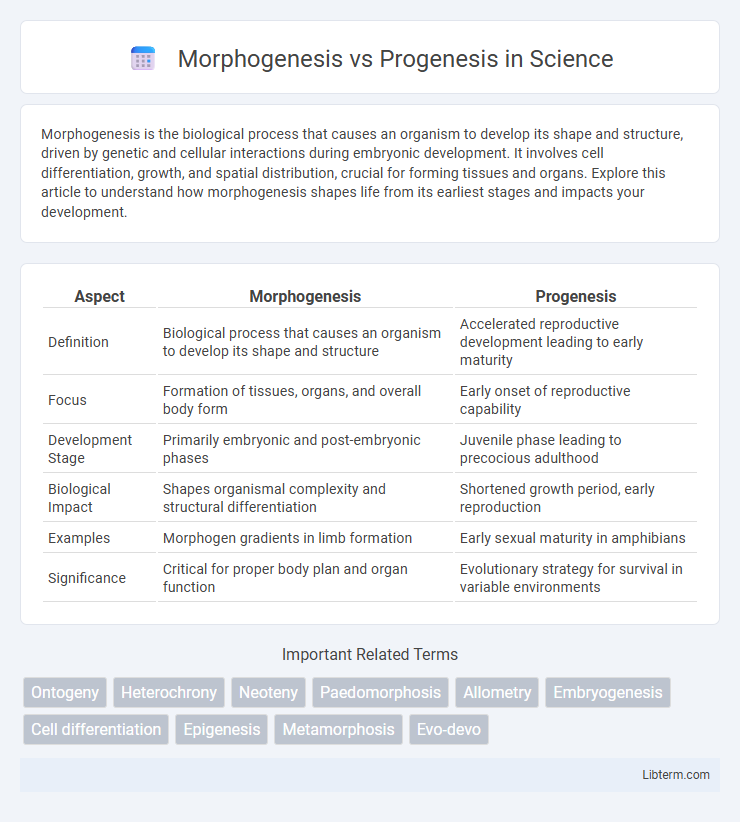Morphogenesis is the biological process that causes an organism to develop its shape and structure, driven by genetic and cellular interactions during embryonic development. It involves cell differentiation, growth, and spatial distribution, crucial for forming tissues and organs. Explore this article to understand how morphogenesis shapes life from its earliest stages and impacts your development.
Table of Comparison
| Aspect | Morphogenesis | Progenesis |
|---|---|---|
| Definition | Biological process that causes an organism to develop its shape and structure | Accelerated reproductive development leading to early maturity |
| Focus | Formation of tissues, organs, and overall body form | Early onset of reproductive capability |
| Development Stage | Primarily embryonic and post-embryonic phases | Juvenile phase leading to precocious adulthood |
| Biological Impact | Shapes organismal complexity and structural differentiation | Shortened growth period, early reproduction |
| Examples | Morphogen gradients in limb formation | Early sexual maturity in amphibians |
| Significance | Critical for proper body plan and organ function | Evolutionary strategy for survival in variable environments |
Introduction to Morphogenesis and Progenesis
Morphogenesis is the biological process that causes an organism to develop its shape, involving cellular growth, differentiation, and spatial distribution. Progenesis refers to the acceleration of sexual maturity, where an organism reaches reproductive capability earlier than usual, often resulting in a truncated development stage. Both processes influence evolutionary adaptation by altering developmental timing and form.
Definitions: What is Morphogenesis?
Morphogenesis refers to the biological process that causes an organism to develop its shape and structural features during embryonic growth through cellular differentiation, proliferation, and spatial organization. This process plays a critical role in the formation of tissues, organs, and overall body architecture. In developmental biology, morphogenesis is essential for transforming a fertilized egg into a fully formed organism with distinct functional systems.
Definitions: What is Progenesis?
Progenesis is a heterochronic developmental process in which an organism attains reproductive maturity earlier than usual, often during a juvenile stage, resulting in a shortened period of somatic growth. This phenomenon contrasts with morphogenesis, which involves the biological processes that drive the shape and structural development of an organism. Progenesis can impact evolutionary trajectories by enabling early reproduction without complete morphological development.
Key Biological Processes Involved
Morphogenesis involves the coordinated cellular processes of differentiation, proliferation, and spatial organization that shape the structure and form of an organism during development. Progenesis accelerates reproductive maturity by truncating somatic growth, often through hormonal regulation that shifts energy allocation from growth to early reproduction. Both processes critically influence developmental timing and organismal form, with morphogenesis focusing on structural complexity and progenesis on reproductive timing.
Cellular and Molecular Mechanisms
Morphogenesis involves intricate cellular processes such as cell differentiation, migration, and spatial organization regulated by signaling pathways like Wnt, Hedgehog, and Notch. Progenesis primarily centers on the acceleration of developmental timing, driven by molecular mechanisms controlling gene expression and hormone regulation, notably involving the retinoic acid and steroid hormone pathways. Distinct regulatory networks govern morphogenesis by shaping tissue architecture, while progenesis modulates the progression of development through temporal control at the cellular and molecular levels.
Evolutionary Significance
Morphogenesis drives the evolutionary significance of organismal complexity by shaping the development of form and structure through genetic and environmental interactions, promoting adaptive traits. Progenesis accelerates evolutionary processes by truncating development, resulting in early reproductive maturity and potential shifts in life history strategies that can influence speciation rates. Both mechanisms contribute to evolutionary diversity by altering developmental timing and phenotypic outcomes, impacting lineage survival and adaptation in dynamic environments.
Morphogenesis vs Progenesis: Major Differences
Morphogenesis refers to the biological process that controls the shape and structure formation of an organism during development, involving cell differentiation, growth, and spatial distribution. Progenesis is a form of heterochrony where an organism reaches sexual maturity earlier, truncating development and resulting in a smaller, often larva-like adult form. The major differences between morphogenesis and progenesis lie in their roles, with morphogenesis shaping the organism's form and progenesis altering developmental timing to influence maturity and size.
Real-world Examples and Case Studies
Morphogenesis involves the biological process where an organism develops its shape and complex structures, exemplified by the embryonic development of limbs in vertebrates such as chickens and mice. Progenesis refers to the acceleration of reproductive maturity, often seen in organisms like the axolotl, which retains juvenile features while becoming capable of reproduction. Case studies in evolutionary biology highlight axolotls as a key example of progenesis, contrasting with species like fruit flies, where morphogenesis shapes distinct adult forms during metamorphosis.
Implications in Developmental Biology
Morphogenesis involves the biological processes that control the shape and structure formation of tissues and organs during embryonic development, playing a critical role in cellular differentiation and spatial organization. Progenesis refers to the acceleration of reproductive development, leading to the early onset of maturity and sometimes resulting in paedomorphosis, which affects evolutionary trajectories. Understanding the balance between morphogenesis and progenesis elucidates mechanisms of developmental timing and evolutionary adaptation in developmental biology.
Future Research Directions and Applications
Future research in morphogenesis and progenesis aims to unravel their genetic and molecular mechanisms to enhance regenerative medicine and developmental biology. Advanced imaging and gene-editing technologies like CRISPR-Cas9 will facilitate precise manipulation of morphogenetic pathways and progenetic timing, accelerating tissue engineering and disease modeling. Investigating these processes in diverse model organisms promises to innovate cancer treatment, congenital disorder prevention, and bioengineering applications.
Morphogenesis Infographic

 libterm.com
libterm.com